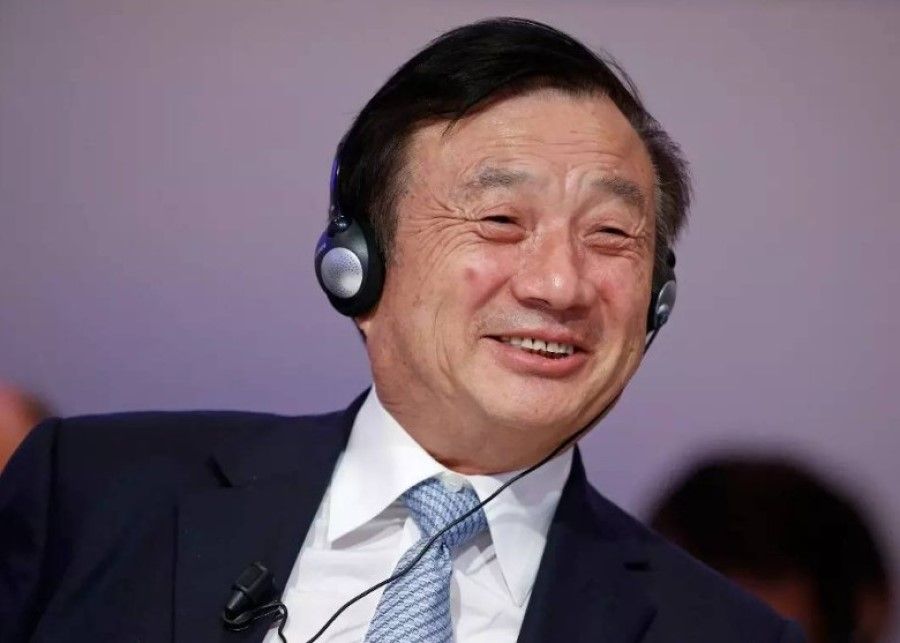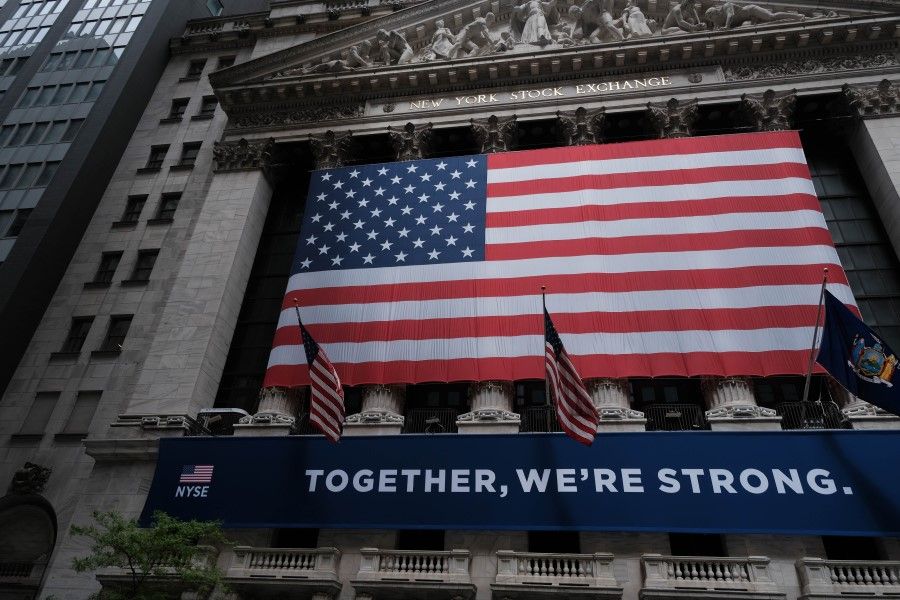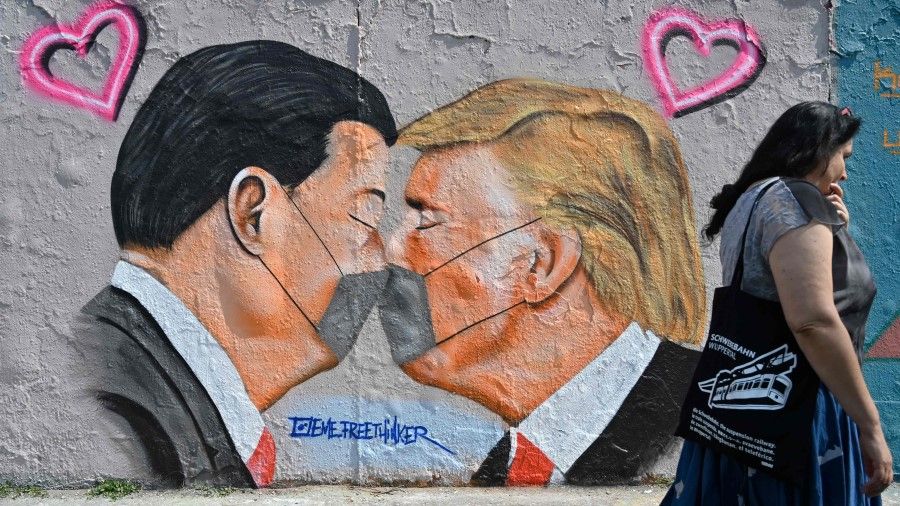Will China and the US fight another wrong war, with the wrong enemy, at the wrong place and time?

Chinese Foreign Ministry spokesperson Hua Chunying once said the synonym for "don't be too US" (做事不能太美国) is "Don't destroy the path behind you as you go forward" (不要走过的路让别人无路可走). That can also be read as: leave others some leeway to move.
Unlike China A-shares (shares of mainland Chinese companies traded on the Shanghai and Shenzhen stock exchanges), which are led by the banking and real estate industries, the most lucrative industry among US shares is the internet- and communications-centred IT industry. According to latest statistics from China's Wind, the 609 US-listed companies in the internet- and communications-centred IT industry in 2019, had a total annual revenue of 15.3 trillion RMB, with total profits of 2.8 trillion RMB, or an average of 18.4%. While A-shares consist of mostly established companies that are generating a steady flow of income, US shares consist of mostly companies that make money through innovation.
The truth is, Huawei has no allies in China that can render it support, not because these Chinese enterprises don't want to, but because they don't have the capabilities or scale.
Huawei is the only Chinese enterprise capable of posing a challenge to half of the US's ICT industry, and striking fear into the other half with its competitiveness and growth trend.
Lonely Huawei lacks strong Chinese allies
At the heart of Huawei's competitiveness is its drive. To me, Huawei is not a "wolf warrior", but a "warrior god", because what drives it is its desire for getting to innovation's core and roots, whether it be of its own origin or that of others. This is what gives Huawei the ability and potential to challenge some of the world's top companies such as Cisco Systems, Qualcomm, Apple, and even Google and Oracle. But this giant slayer needs to set boundaries and offer its rivals a way out, otherwise, it will be surrounded and destroyed by the latter.
The truth is, Huawei has no allies in China that can render it support, not because these Chinese enterprises do not want to, but because they do not have the capabilities or scale. Hence, the Chinese government, Huawei, and Huawei's formidable rivals with a powerful influence on the US government, will have to talk it out and have tough negotiations to remove fears and concerns, or even turn enemies into allies. Huawei needs at least five to ten years of peaceful coexistence and mutual prosperity to allow other Chinese enterprises to grow strong and become true allies.
Huawei rotating chairman Guo Ping once said, "Huawei is not capable of chip production although it designs chips. We are still working on a solution and survival is the keyword for Huawei right now." Chip production includes design, manufacturing, packaging, and testing. China's semiconductor industry is strong in packaging and design, but weak in manufacturing.
In 2018, Huawei's R&D spending was 102.9 billion RMB, the fourth highest in the world ahead of Microsoft and Apple. In 2019, that figure was 131.7 RMB, or 15.3% of its sales revenue. But Huawei is the only company in China that is truly willing to invest in R&D, and therein lies the difference between Huawei and other Chinese enterprises - their willingness to spend to build an effective system based on the drive for innovation. As Huawei CEO Ren Zhengfei said, "Huawei is a distribution system for value and value creation, founded on both financial and labour capital."

The lack of emphasis on innovation in China's post-graduate education, the mercenary pursuit of money, and the veneration and fear of the West has led to superficiality and the absence of the drive for innovation in China. No amount of meetings by the Chinese government could match building a system of motivation so that China would be filled with enterprises like Huawei, whether state-run or private, large or small. And a country with a good number of such enterprises would find it difficult not to be a world leader, even if it did not want to be.
When the US dominates technology
Not all of the companies joining in the attempts to choke out and destroy Huawei are willing parties. Although they are reneging on a social contract, it cannot be helped because the US dominates the technology. Today, Huawei, tomorrow, it may be Samsung or some other company. Huawei is feeling the pain, while many others are feeling the fear.
The internet has 13 root servers, the Windows operating system is the core of PCs, the Android system is the core of Android mobiles, and the ARM framework is the core of the global computer chip industry. Even a "core" company like Arm Holdings uses a lot of technology that originated in the US. (NB: Arm Holdings, owned by Japan's Softbank Group Corp, is often described as the most successful technology company in the UK.) A top global chip company like Taiwan Semiconductor Manufacturing Company (TSMC) also gets its base materials from US companies such as Applied Materials and Lam Research. Therefore, TSMC's core remains in the hands of the Americans. The Chinese-owned Semiconductor Manufacturing International Corporation (SMIC) would find it difficult to catch up with TSMC; even if it did, it would be difficult to free itself from US control. And that is to say nothing of the ruthless "pull them up by the roots" style of elimination of the US financial system.
China and the US are currently at different phases of development and possess disparate characteristics. In that sense, they should be each other's ballast In the next 30 to 50 years.
However, technology is advancing and chip processing may be obsolete in ten years, when most storage and processing functions can be handled through cloud processing. That would significantly reduce demand for high-end chips.
When China owns the market, the supply chain, and US debt
China and the US are currently at different phases of development and possess disparate characteristics. In that sense, they should be each other's ballast In the next 30 to 50 years. The US gave Huawei a 120-day buffer period not out of kindness, but because it still has doubts about eliminating it completely.
The failure of the Occupy Wall Street movement and gun control efforts illustrate the failure of the US democratic system, and the fact that arms dealers and Wall Street capitalists are the ones who are really in charge in the US. The Republican Party has become purely interest-driven, while the Democratic Party that represents the grassroots has devolved into dainty egoism. The result is that the Republicans and Democrats do not have an effective plan to stop the shrinking proportion of the middle class in the US.

If US companies are pulling production back to the US due to national security reasons, they will see a significant drop in profits and competitiveness in relation to European and Japanese companies, and the US stock market will see a long bear run. That bear run in itself would be comparatively minor, but the external circulation of China-owned US debt is the key to undoing the Ponzi scheme that is the US national debt. The purchasing power of the US dollar works through the circulation of valueless paper as guaranteed by a Ponzi-style national debt. And China holds the key to whether this cycle will continue: to continue buying up US debt with the trade surplus in US dollars generated through China's manufacturing, leading to external circulation of US debt. So, in this sense, China lies at the crux of whether the US can continue to operate steadily. The US debt and the US dollar are two sides of the same coin, providing mutual guarantees and circulation.
At this juncture, the relationship between them is that of the US giving commands and China executing them.
The appeal of China's enormous market and the hollowing out of US industry is at the heart of why the US is in awe of China. Each holds the lifeblood of the other, and each will bring the other down if it falls. There can be no harmony in the world without harmony between China and the US; these two countries should avoid war of any sort.
The US leads while China executes
China is like a big panda that will not show its nature unless it is pushed, and one thing Americans should realise is that the adorable panda and fearsome bear come from the same family. Understanding this will help prevent China-US decoupling and avoid war, cold or otherwise. This needs to be supported by the will of the nation and its people.
I refer to China and the US's association as a "global anchor". More specifically, it is made up of the US debt and US dollar, and China manufacturing. If this global anchor fails, that would be the beginning of the end of the world.
At this juncture, the relationship between them is that of the US giving commands and China executing them - the US innovates at the fore of the figurative ship and China sets a course in the aft as they work together to build a harmonious world. That is in line with China's traditional concept of yin-yang and balance, as set out in the I Ching. Such a relationship framework between China and the US would be logical and complementary, with potential for sustained growth. If China-US relations could be like that, it would be a boon for the people of the world.
The ones who are unwilling or unable to decouple from China are the Wall Street capitalists (except for the US arms dealers - their dream model to have industries return to the US is war).
China and the US must resist decoupling or face war
Decoupling would cause enormous losses to both Chinese and Americans. If and when decoupling does happen, it would be a coming of age for China in terms of totally weaning itself from the US, and it will be akin to receiving a certificate of independence and autonomy.
The clash of populist ideologies, leading to a war, will effectively force a decoupling.
To avoid decoupling, China has to focus on creating its own path and growing its own market. Of course, it can also achieve that by a show of bravado. To spread the word among stakeholders in China that China will take the initiative to decouple, so that these stakeholders will exert pressure on the US government. The most successful example would be Mao Zedong calling the US's bluff about using nuclear weapons during the Korean war, with his line that if the US dropped a nuclear bomb, China would retaliate with hand grenades - that is to say: I don't care. In fact, US stakeholders are the ones who are really concerned about decoupling.
Conversely, the quickest and surest way for China and the US to decouple is for both governments to use a war to distract the people from domestic issues. The clash of populist ideologies, leading to a war, will effectively force a decoupling.

China's core narrative is to use the market as a key link to create and entice competition between the US and Japan, and the US and Europe, in terms of investments. The globalisation of economies will not change, and East Asia is currently the centre of the global manufacturing network. The cooperation and distribution of industrial labour between China and foreign investments has led to increasing integration between industrial chains. In terms of demand for innovation and improvements in product quality at lower costs, foreign-funded companies in China, and in Europe, the US and Japan, still complement and need one another. Only war can forcibly break this complementary relationship, but that option would cause an unmitigated disaster for China, the US, and the world (except for US arms dealers).
China and the US should commiserate and work together, and not carry different agendas and turn on each other. After all, both countries face domestic issues as their root problems, while sharing the same global village.
Global impact of US-China conflict
The biggest potential victims of a China-US conflict (especially a hot war) would be Japan, Korea, Taiwan, Southeast Asia, and the European Union (EU). Russia's territorial bloodlust is the biggest potential threat to the EU; it only lacks the opportunity, and a hot war between China and the US would provide that. Russia will cash in on whatever military advantage it still has.
China's GDP in 2010 overtook Japan's, and Japan's worries were reflected in its claim of the Senkaku Islands. Now, it is the Americans who are worried. And this worry can be resolved in two ways. One, China grows so big that the US has to accept it. Two, both sides go all out and clash head-on - but that would lead to both sides getting hurt, without a winner.
Without the support of Japan, Korea, and the EU, the US will not start any sort of war with China.
China has recently started talking again about developing its western region, which is like Mao Zedong's "Third Front" preparatory construction; the western region development is related to "expanding the strategic space for national development" (扩展国家发展的战略回旋空间) and "ramping up defenses to resolve risks" (增强防范化解各类风险能力). Clearly, China is prepared. Besides, the US is geographically far from Asia, while China's guided missile technology and land-based aviation is far superior to long-distance attacks from an aircraft carrier. These are weaknesses that the US cannot overcome.
The key to preventing China and the US from decoupling and slipping towards war - cold or hot - lies in the relationships between China, Japan, and Korea, as well as between China and Europe. Without the support of Japan, Korea, and the EU, the US will not start any sort of war with China. And the solution is for China and the US to set boundaries and build a new inclusive relationship between powers.
What China wants in its competition with the US is the right to development, as well as national unification and total authority over its territory.

What China wants in its competition with the US is the right to development, as well as national unification and total authority over its territory.
Currently, China is in a passive state of defence. But to draw an analogy from football, in a World Cup final, usually, it is the team that defends and then counterattacks that has the last laugh and wins the championship in the end. It is the same when countries compete: a prime example would be the two biggest players in WWII, namely Germany with its Blitzkrieg strategy designed for sharp and swift blows for a quick win and Japan with its sneak attacks. Both lost the war in the end. It is the same with the US. Riding on its victory in WWII, it led the armies of 16 UN members into North Korea, and yet failed to win the Korean War.
The US is even less likely to win against China today. China's success against the coronavirus shows how the Chinese government is capable of gathering efforts to achieve big things, and the ability of a strong country to mobilise its people, as well as the people's unity. War is also a big thing - a very big one in fact.
Hopefully, China and the US will not repeat the woeful steps of the last century, only to realise that they have fought a wrong war with the wrong enemy in the wrong place at the wrong time, after going to the battlefield with each other.
China and the US should remember that one country's loss may not be the other country's gain. The most probable outcome is either cooperation for a win-win result, or conflict leading to a lose-lose situation.
The Huawei situation shows that a more inclusive China-US relationship is needed, because when two populist ideologies clash, the result is mutual destruction, which will be an enormous disaster for the world.
As the Chinese saying goes, a just cause gains much support, an unjust cause gains little, while a non-cause gains none (得道多助,失道寡助). Hopefully, China and the US will not repeat the woeful steps of the last century, only to realise that they have fought a wrong war with the wrong enemy in the wrong place at the wrong time, after going to the battlefield with each other.
